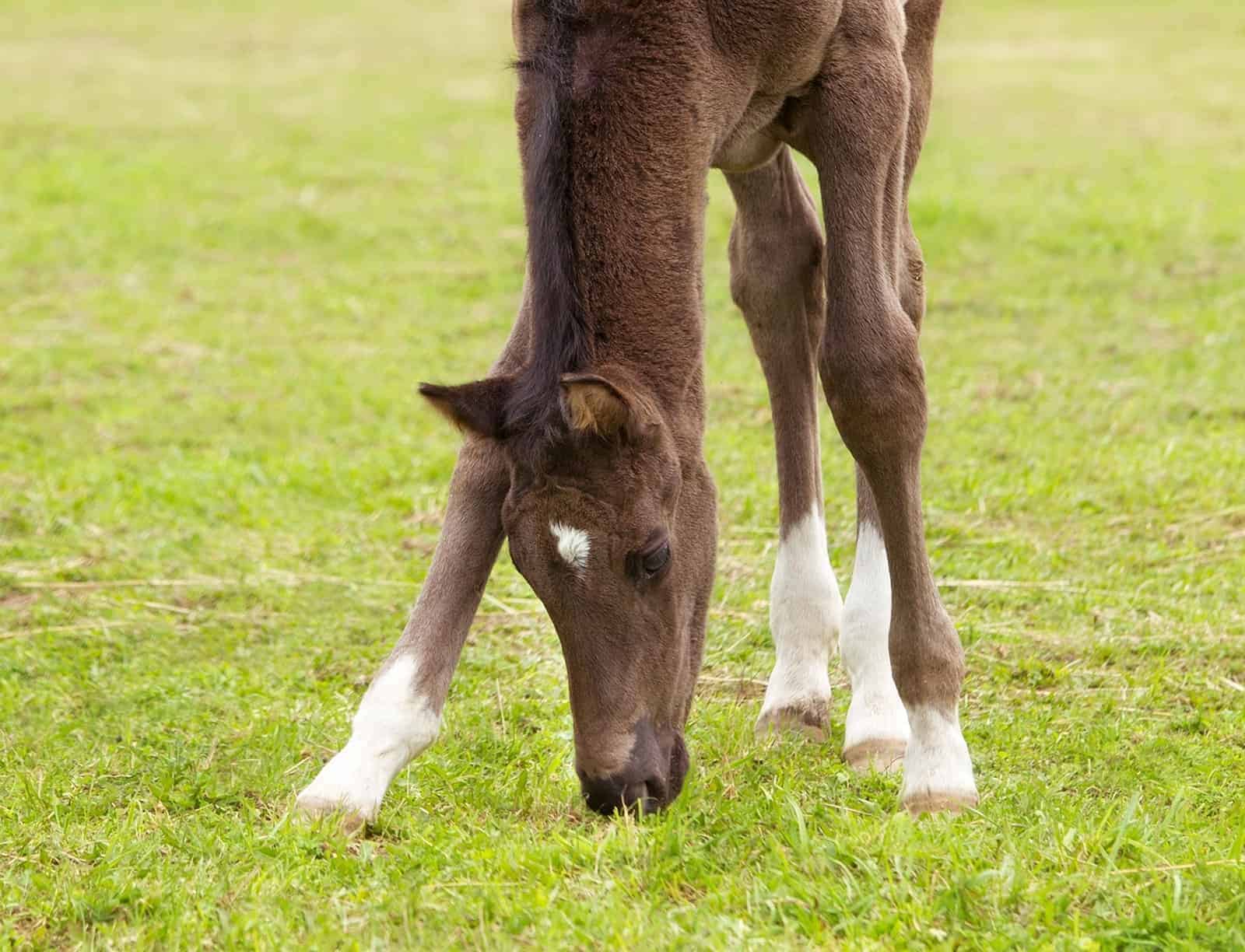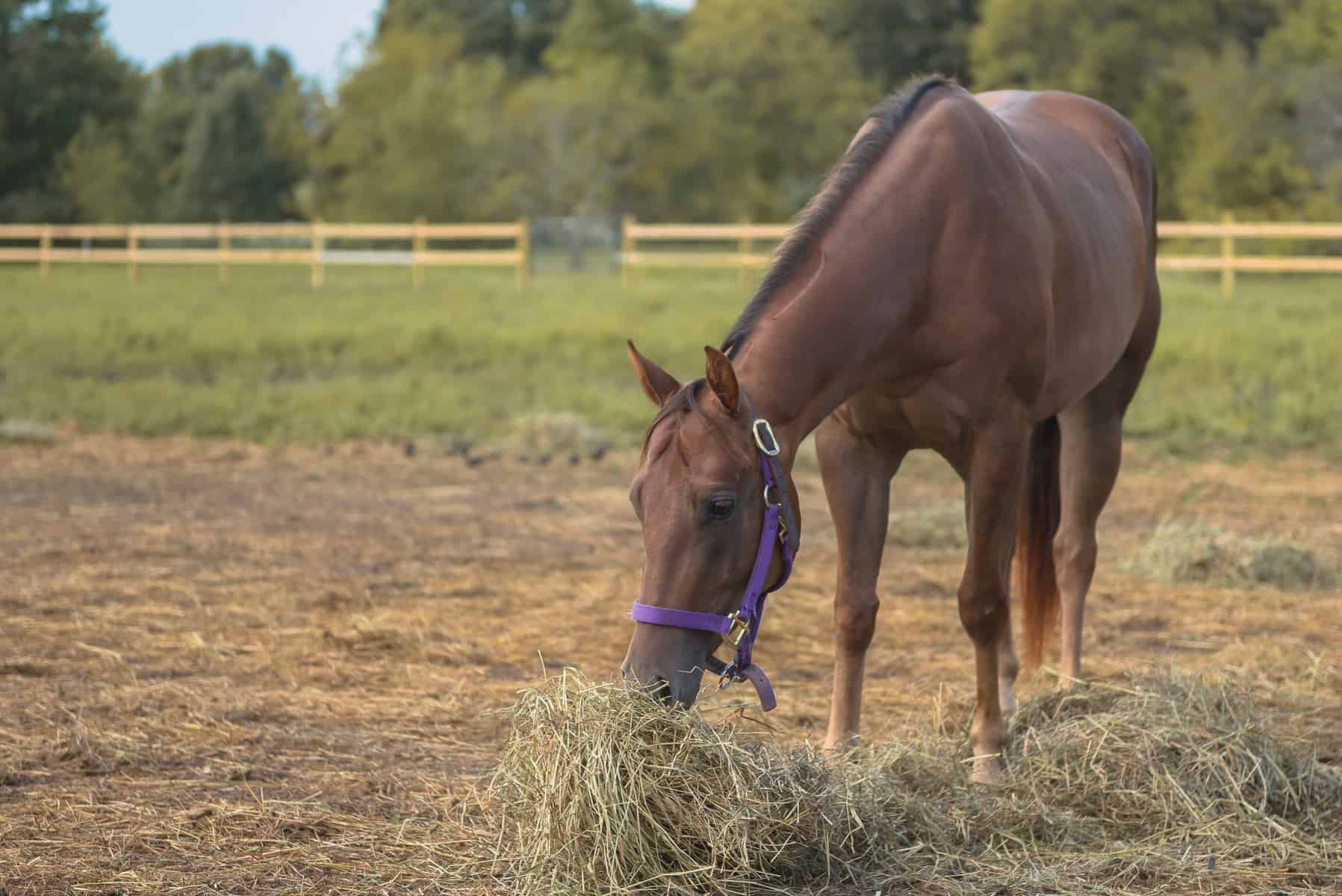Feeding Nonworking Horses

Do’s and don’ts to meet the dietary needs of retirees and pasture pets
For creatures of any species, proper diet and exercise are key to maintaining health and proper body weight and condition. But when a horse isn’t getting regular exercise, the onus falls on diet alone. And, of course, this presents its own set of challenges.
A horse might be idle for a variety of reasons. He could be a senior mount who has served his time in work and is enjoying a well-deserved retirement. She could be a young prospect who is getting time to grow and mature before starting in training. Or he could be a mature campaigner with a performance-limiting injury who’s embarked on a new career as an equine babysitter.
No matter the reason for horses’ inactivity, and even if they’re not being managed as intensively as is typical, owners must remain attentive to these animals’ diets. In this article you’ll learn some do’s and don’ts for promoting nonworking horses’ optimal health (and preventing potential problems) with nutrition.
Defining “Nonworking”
“When a horse is not working, we often refer to them as being ‘idle’ and, more than likely, we are talking about a horse that is either retired or is idle due to disease, injury, weather/season or time of year, or perhaps in between competitions or events,” says Amanda Adams, PhD, MARS EQUESTRIAN Research Fellow at the University of Kentucky M.H. Gluck Equine Research Center, in Lexington. “Or in my case they are simply part of the family and, if we are both lucky, we trail/pleasure ride a few times a year, time permitting and, thus, there is quite a bit of ‘idle’ time.”
As it turns out, idle horses make up a large portion of the equine population in the United States. “The latest reportings from American Horse Publications, in 2018, listed the top two ‘use of horse’ categories were for trail/pleasure riding and idle/retired/not working,” she says.
Don’t: Ignore Body Condition
While your nonworking horse doesn’t necessarily need to carry a rider around a jump course or up and down a trail, his fat cover remains an important part of his overall health, says Krishona Martinson, PhD, professor and equine extension specialist at the University of Minnesota College of Food, Agricultural and Natural Resources Sciences’ Department of Animal Science, in St. Paul.
“We know that both thin and obese horses are at a greater risk for certain disorders compared to horses at a healthy or recommended body weight,” she says. “For example, horses that become overweight have a higher chance of suffering from laminitis and tend to have challenges controlling their body temperatures (e.g., can overheat).”
Conversely, underweight horses could lack the fat stores necessary to withstand low temperatures and other stressful situations. They can develop health issues such as weakness and impaired gastrointestinal function, wound healing, and immunity.
Do: Evaluate Weight and BCS Regularly
Nutritionists and veterinarians recommend keeping horses around a body condition score (BCS) of 4 to 6 on the 9-point Henneke scale. The trick to maintaining a healthy weight and BCS? Monitoring them regularly so changes don’t sneak up on you.
“We recommend that owners track their horse’s body weight and body condition score on a monthly basis,” Martinson says. “It takes a minimal amount of time and can easily be done while grooming.”
A scale is the most accurate way to evaluate body weight; however, few owners have frequent access to a scale. Instead, they can estimate body weight using a weight tape or formulas such as those offered on TheHorse.com (TheHorse.com/weightcalculator) or the Healthy Horse smartphone app, which Martinson helped develop at the University of Minnesota.
“Research has found that the Healthy Horse app results in a more accurate estimation of body weight compared to the equations and a weight tape,” she says. “Similar to mathematical equations, the app requires owners to take four measurements—height, neck circumference, body length, and girth circumference—and, once entered, the app estimates body weight.”
Likewise, owners should evaluate a horse’s BCS to identify changes, subtle or pronounced. Find a step-by-step guide on determining BCS at TheHorse.com/164978.
Also consider a horse’s cresty neck score, or CNS, Adams says. “The CNS evaluates the amount of fat in the neck region of the horse using a scale from 0 (no visible crest) to 5 (large crest that falls to one side),” she says. “The ideal CNS is 2 or lower; a score of 3 or greater has been recently shown to be a predictor of insulin dysregulation.”

Do: Consider the Horse’s Life Stage
Whether young and unbroke, mature and injured, or old and retired, your idle horse has specific nutrient needs based on life stage. For example, Martinson says, young horses have unique and important nutrient requirements to ensure safe and consistent growth and skeletal development and to put them on the right path for good health over their entire lives.
Pregnant and lactating mares require enough calories and nutrients for themselves plus their developing dependents.
Then there are our senior equine friends that face a number of possible health issues that impact body condition and nutrient requirements, from dental issues to diminished digestive efficiency. They might require a higher-fat diet than a normal adult horse to help maintain weight, or they might not be able to chew hay or grass well enough for their bodies to extract the nutrients they need.
Adams, who’s studied older horses extensively, cautions that it’s important to consider the aging horse’s metabolic status to pinpoint or rule out underlying issues that could impact his or her ideal diet, such as equine metabolic syndrome, insulin dysregulation, or pituitary pars intermedia dysfunction (equine Cushing’s).
“Metabolic status will definitely drive how the horse is managed and what diet they should be maintained on,” she says.
Dr. Amanda Adams
Don’t: Overlook Nutritional Needs
Idle horses or horses at maintenance have similar vitamin, mineral, protein, and other requirements as working horses, even though they’re not working.
“It’s best to reach out to an equine nutritionist, local extension educator, or veterinarian to help you determine what type of diet your horse should be maintained on,” Adams says, but notes key points to remember about any horse’s diet:
- Forage (grass and/or hay) should be the foundation. “A horse typically requires 1.5-2.5% of their body weight in forage daily, and this varies depending on their BCS, age, and working status,” she says.
- Having hay analyzed is key to ensuring a horse’s nutritional needs are being met. You can work with an extension agent to help with this, or you can send a sample for analysis to a forage laboratory (such as EquiAnalytical).
- Importantly, provide adequate clean, fresh water, because an average size horse will drink 5-10 gallons per day.
If horses are at a healthy body weight and have access to good-quality hay, then a ration balancer is usually the only additional feedstuff needed, Martinson says (more on these in a moment). “And if the horses are on pasture for the majority of the time, it’s possible no additional feedstuffs are required,” she says.
Keep in mind that while good-quality pasture can supply all the nutrients some horses need, it can inevitably lead to unwanted weight gain.
“In this case, a grazing muzzle can help limit intake while keeping the horse on pasture,” Martinson says.
Of course, reducing pasture intake reduces the nutrients a horse consumes, so muzzled horses might also benefit from a ration balancer to meet their nutritional needs. Again, “working with an equine nutritionist is the best way to ensure your horse, regardless of activity level, is getting proper nutrition,” Martinson says.
Do: Consider Ration Balancers
For idle horses that need proper nutrient levels without the calories of commercial feeds, balancers are the answer.
“A ration balancer is essentially a supplement because it is not a complete feed or a performance feed,” Adams says. “It does not provide calories, as it is designed to only provide (high-quality) protein, vitamins, and minerals that may be lacking in a horse’s diet. A ration balancer is a heavily fortified formulation that is fed in small amounts of 1 to 2 pounds per day per horse that (balances the diet) without causing the horse to pack on additional pounds.”
Another reason they’re helpful for idle horses is, because of their low-calorie status, they’re low in starch and sugar, or nonstructural carbohydrates (NSC). For this reason, says Adams, they have a low glycemic index that’s ideal for horses with metabolic issues, especially those prone to laminitis.

Do: Increase Forage First for Underweight Horses
Yes, many idle horses gain weight in the absence of regular exercise. But a few will drop pounds or remain lean when they’re not in work. Owners might discover a horse doesn’t thrive in a 24/7 turnout scenario, for instance, or temperature extremes might result in weight loss. Underlying medical issues, such as poor dental health or undiagnosed infections, could cause a horse to be underweight, and Martinson says it’s important to rule those out first before adjusting the diet.
“Assuming there are no underlying medical issues, it usually best to either increase the amount (or) quality of forage fed,” she says. “For example, going from a poor-quality grass hay to a better-quality grass-legume hay can sometimes be enough to result in weight gain.”
She cautioned horse owners to make any dietary changes slowly over the course of seven to 10 days.
Consistent Attention Is Key
Just because a horse isn’t actively working doesn’t mean his diet isn’t an important part of his well-being.
“All horses, regardless of working status, have nutrient requirements that need to be met,” Martinson says. “For adult idle horses or pasture pets, keeping these horses at a healthy body weight is usually the challenge.
“Consistently tracking body weight, body condition score, and other indicators of healthy body weight are key,” she adds. “Using research-based tools is also important and include grazing muzzles while on pasture, slow-feed haynets, and ration balancers. Finally, these horses rarely require grain, and owners should focus on maximizing forage in the diet.”
Adams recommends turning to the experts if you are unsure of how to monitor your horse’s condition or design his diet. “That’s their job, let them help guide you,” she says. “Don’t guess, ask, because guessing can lead you and your horse down the wrong path.”

Written by:
Erica Larson
Related Articles
Stay on top of the most recent Horse Health news with












